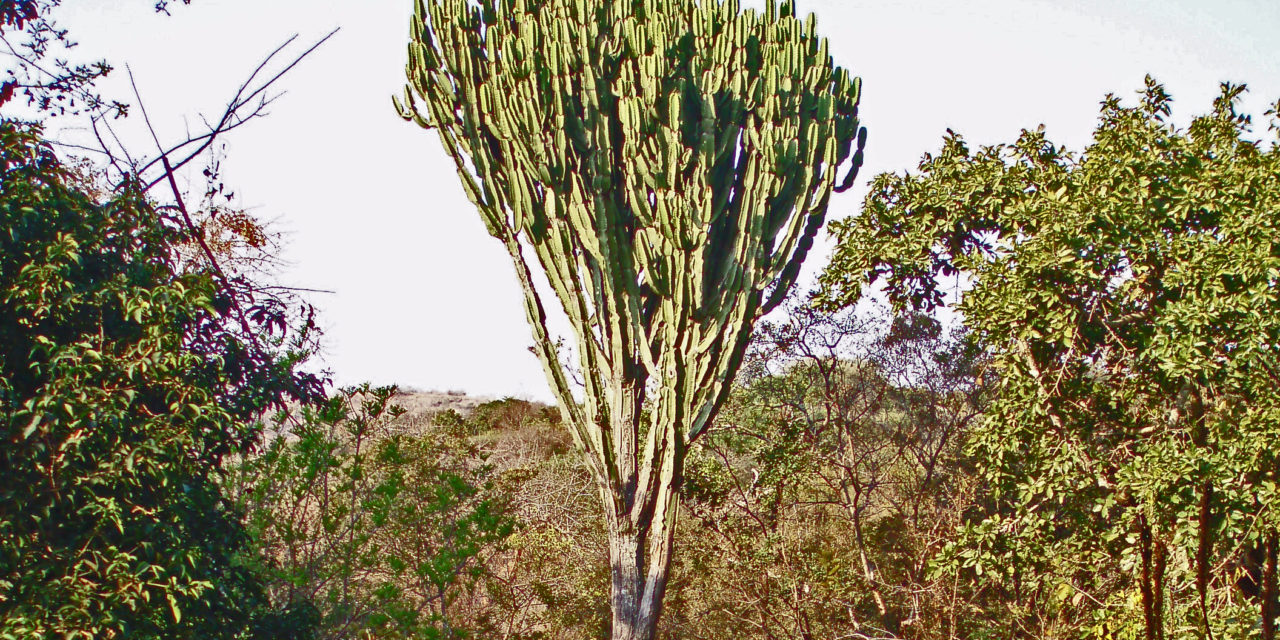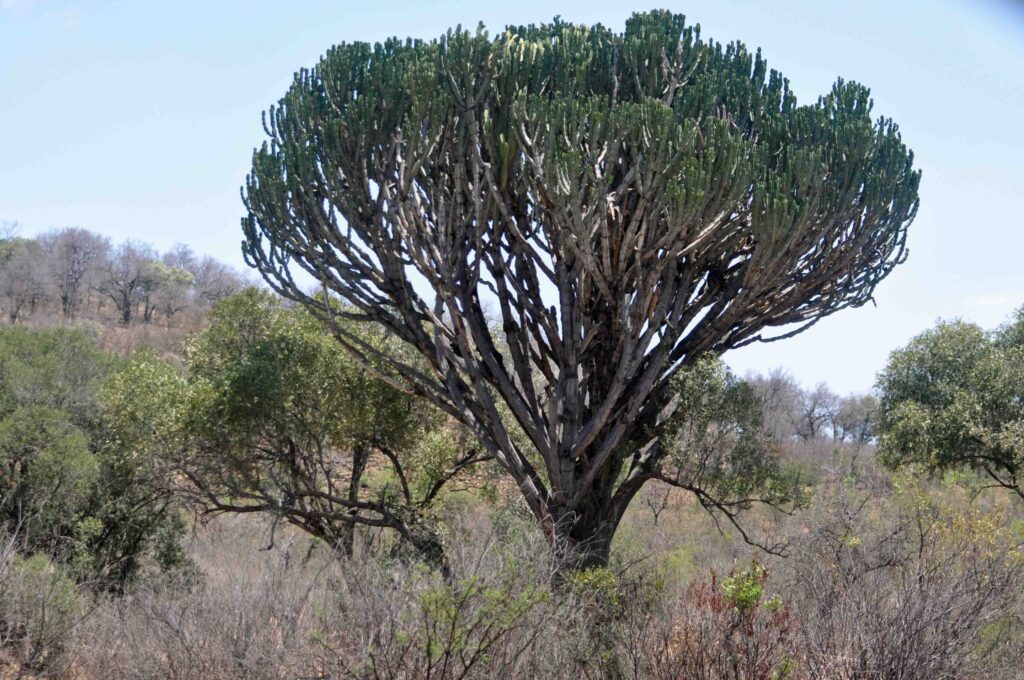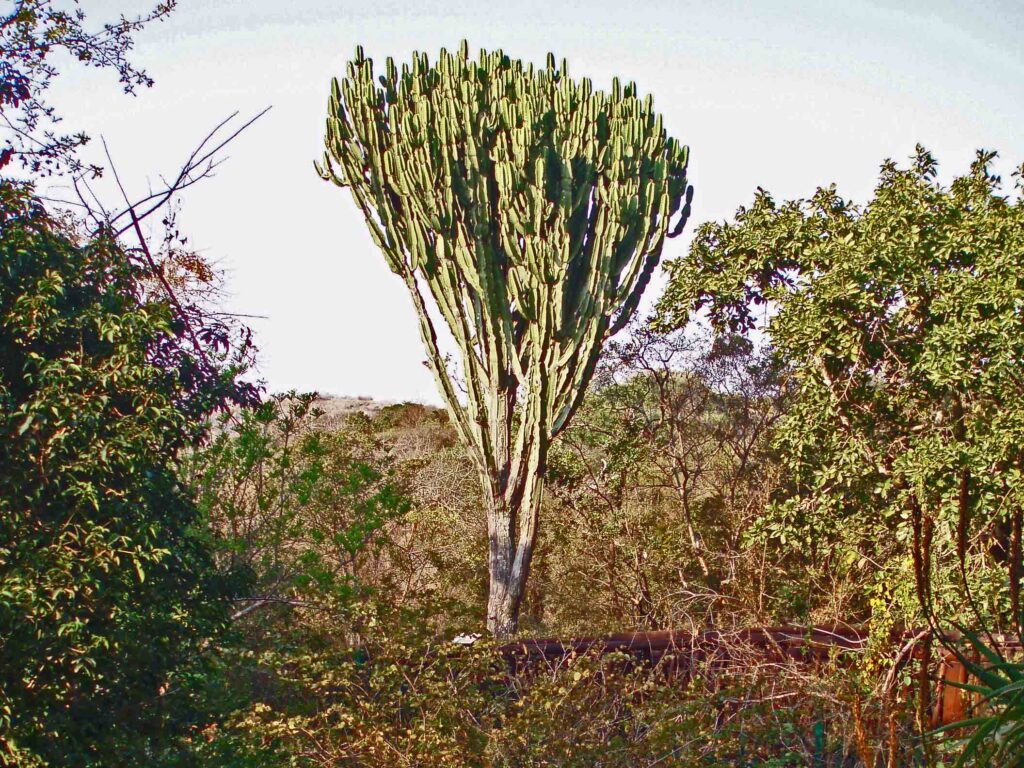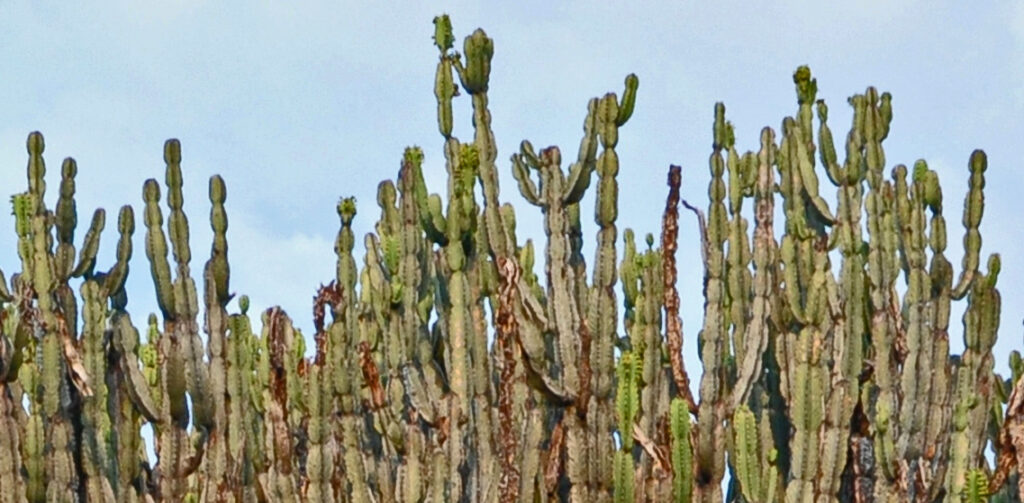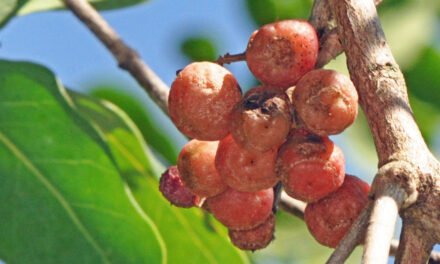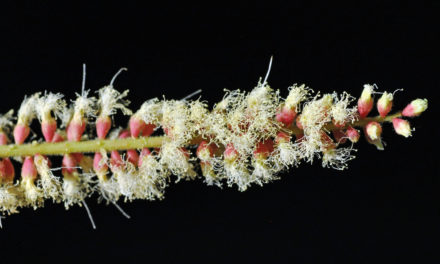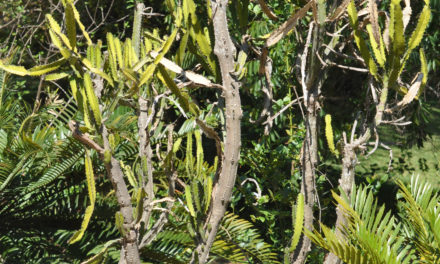General Info – summary
This monoecious, massive, sturdy, succulent Tree has a rounded crown and is up to 10m+ high. Many lower branches do not die off. Toxic latex and paired spines develop on spine-shields. Small Leaves fall early. Unisexual Flowers, on wing ridges are in cyathia. Each male flower has 1 stamen and each female flowers has 1 pistil – with a superior ovary, 3 styles and 3 stigmas. The Fruit a small, woody capsule.
Description
Euphorbia ingens
Previous Names: Euphorbia cooperi, Euphorbia natalensis, Euphorbia similis.
SA Tree No. 351.
Common names: (Afr) Gewone Melkboom, Gewone Naboom, Gewone Melkboom, Gewone Naboom, Kankerbos, Naboom, Noorsboom, Noorsdoring, Noorsdoringboom, Noorsheuning. (Eng) Cactus Euphorbia, Candelabra Euphorbia, Candelabra Tree, Common Tree Euphorbia, Tree Euphorbia, Giant Euphorbia, Naboom. (isiNdebele) Ikonze. (isiZulu) Abaphaphi, Umahetheni, Umhlondlo, Umhlonhlo, Umphapha. (Northern Sotho) Mohlohlo-kgomo, Abaphaphi, Mokgoto, Mokgwakgwatha. (Setswana) Monkgôpô, Ngôgô, Nkonde, Nkondze. (siSwati) Ishupa, unHlonhlo. (Tshivenda) Mukonde. The vilage Naboomspruit (- now Mookgopong), North of Pretoria, took its name from this tree.
Family Euphorbiaceae (Euphorbias family e.g., the exotic poinsettia – Euphorbia pulcherrima). This family has about 275 genera and 7 500 species with a very wide distribution. In South Africa, there are 50 genera and 484 species. Apart from Antarctica, members of this family are present in all continents. This family has many herbs, and in the tropics, shrubs and trees, including succulents and climbers, are more common. Local tree containing genera on this website include Croton, Euphorbia, and Spirostachys. Leaves, when present, are usually alternate, simple and stipules usually appear as hairs, glands or spines. The regular plants may be monoecious or dioecious. Inflorescences are situated terminally or in leaf axils. They are mostly in cymes (a broad, more or less flat-topped, determinate flower cluster, with central flowers opening first). Colourful bracts may be present below the flowers.
Name derivation: Euphorbia – after Euphorbus (50BC-AD19): physician to the king of Mauretania. ingens – huge – referring to the massive, much-branched rounded crown. The Genus Euphorbia has many species in southern Africa.
Conservation: National Status: L C. (Least Concern). Assessment: 2005 (R.H. Archer and J.E. Victor).
Tree
This sturdy Tree is up to 11m high, with a massive, single, rounded and succulent Crown (photo 32). The grey Bark becomes roughish. In most tree species of Euphorbia – not this one – the lower branches all die off. Here many ot the persistent, lower, dense branches do not break off from the established Stem (main axis of the plant, the leaf and flower bearing as distinguished from the root-bearing axis). The straight, erect and persistent Branches generally develop and remaine attached close to the tree base. From here, these branches develop Branchlets (a small branch or division of a branch – especially a terminal division and is usually applied to branches of the current or preceding year). These branchlets are up to 12cm in diameter, have 4-5 wing-like angles and are irregularly constricted forming parallel sided segments (photo 535). Simple paired Spines are up to 5mm long and are usually present on the almost vertical edges of the wings. They may be absent on old trees. The spines arise on horny bases called Spine shields. In this plant the spine shields are separate from each other and are often in slight hollows on the wing margins. There is thus no continuous shield ridge. Caustic Latex is present. These plants are succulent and cactus like, but the true cactus lacks the paired spines and the toxic latex present in this Euphorbia. Euphorbia cooperi is similar but smaller and the branches may be 5-6 angled.
- 684. 2018/11/18. Pilansberg. NR. Photo: David Becking.
- 32. 2008/08/09. Lowveld NBG. Photo: David Becking.
- 553. 2018/04/29. Nylsvley NR. Photo: David Becking.
Leaves
This deciduous tree has Leaves that fall very early and are oblanceolate (the reverse of lanceolate, as leaf broader at the apical third than at the middle and tapering towards the base). They may be up to 8cm long – in very young plants only.
Flowers
The tree is monoecious (having both male and female reproductive organs on the same plant). Flowering branches are green with wing-like angles that are constricted into segments that are up to 8cm long and broadest in the centre. Close to branch-ends, the small yellow-green Inflorescences (a group or cluster of flowers arranged on a stem) are situated on the wing-ridges, just above the spines. Individual flowers occur in an inflorescence called a Cyathium (the name given to the cup-shaped Euphorbia inflorescence that appears to be a single flower but is, in fact, a collection of reduced male and female flowers). Here each flower lacks a Perianth (neither sepals nor petals are present).
The individual flowers are unisexual – either male or female. Each Male Flower is reduced to a single Stamen with one Filament that ends in a 2-thecous (with 2 pollen sacs) Anther. This anther dehisces longitudinally. Many such male flowers surround the single female flower. Each Female Flower has a single Pistil with a stalked, superior Ovary that has 3 locules, each containing a single pendulous Ovule. There are usually 3 Styles and 3 Stigmas present. Pollinators are insects that are attracted by the surrounding coloured nectar glands and modified bracts. These bracts resemble petals. (Mar-Jul).
Fruit
The smooth, dehiscent, stalked Fruit is a 3-lobed Capsule (a dry fruit resulting from the maturing of a compound ovary which usually opens at maturity by one or more lines of dehiscence). The reddish, purple fruit may colour the tree slightly. It is globose (spherical or nearly so), up to 1 x 0,7cm and situated at the end of a stout stalk. When mature, it becomes purplish and woody. (Jul-Oct).
Distribution & Ecology
These conspicuous plants usually occur at an altitude of between 300 and 1 500m. They are common on rocky outcrops, in deciduous woodlands, flat bushveld, hills and savannah (a rolling grassland scattered with shrubs and isolated trees). They often occur close to termite mounds. Provinces where they occur include KwaZulu-Natal south coast and northwards to Gauteng, Mpumalanga, North West and Limpopo. They also occur in Swaziland, Zimbabwe, northern and southern Mozambique and northwards into Tropical Africa. This is the most photographed Euphorbia species in South Africa. The growth form enables these trees to conserve water and their lack of leaves is compensated for by the stems – especially the younger ones being photosynthetic. These Euphorbias are one of the few plants that use 3 different photosynthesis mechanisms. An “unusual” one of these is CAM photosynthesis (Crassulacean acid metabolism). Here the stomata – structures utilising 2 guard cells which, unlike lenticels, can control the gaseous exchange between the plant and the surrounding atmosphere – only open at night to preserve moisture. During this dark period, they collect and store carbon dioxide to use during the daylight for photosynthesis). Birds, like the Black-collared Bulbuls, Crested Guineafowl, Emerald-spotted Wood Doves, Franklins and Turtle Doves feed on the Fruit. Old Wood is used by Woodpeckers for nesting. The Roots are eaten by porcupines and cane-rats. Flowers, including buds, are eaten by vervet monkeys (Chlorocebus pygerythrus). Dingaan’s throne is believed to have been built under such a tree.
Ethnobotany
This tree can be Grown from seed or truncheons (stem cutting from a selected plant – used to produce genetically identically new plants). Some local people believe that the tree attracts lightning. These plants should not be over-watered in winter. Due to the poisonous latex, great care should be taken when handling this plant. In all Euphorbias, the Latex like sap is very poisonous – causing blistering, allergic reaction or even blindness. The latex is used to stun fish. It is also used in local medicine. Prior to cutting, the tree is often subjected to fire which decreases the effect of the toxic sap. This heating method, prior to cutting, is also used with another member of the Euphorbiaceae family: the Tamboti tree (Spirostachys africana). The tough Wood from the main trunk, which has a low density, is used for making canoes, planks and doors. Honey from these trees causes burning in the mouth.
References
Archer, R.H. & Victor, J.E. 2005. Euphorbia ingens E.Mey. ex Boiss. National Assessment: Red List of South African Plants version 2020.1. Accessed on 2023/05/21.
Boon, R. 2010. Pooley’s Trees of eastern South Africa. Flora and Fauna Publications Trust, Durban.
Burrows, J.E., Burrows, S.M., Lotter, M.C. & Schmidt, E. 2018. Trees and Shrubs Mozambique. Publishing Print Matters (Pty) Ltd. Noordhoek, Cape Town.
Coates Palgrave, M. 2002. Keith Coates Palgrave Trees of Southern Africa, edn 3. Struik, Cape Town.
Lawrence, G. H. M, 1951. Taxonomy of Vascular Plants, The Macmillan Company, New York. Tenth Printing 1965.
Palmer, E. & Pitman, N. 1972. Trees of southern Africa, Balkema, Amsterdam, Cape Town.
Schmidt, S. Lotter, M. & McCleland, W. 2002. Trees and Shrubs of Mpumalanga and the Kruger National Park.
van Wyk, B. & van Wyk, P. 1997 Field guide to Trees of Southern Africa, Struik, Cape Town.
https://en.wikipedia.org/wiki/Euphorbia
www.plantzafrica.com/plantefg/euphorbingen.htm
https://en.wikipedia.org/wiki/Euphorbia_ingens
http://www.operationwildflower.org.za/index.php/plant-records/euphorbias/114-euphorbia-ingens
http://posa.sanbi.org/flora/browse.php?src=SP

